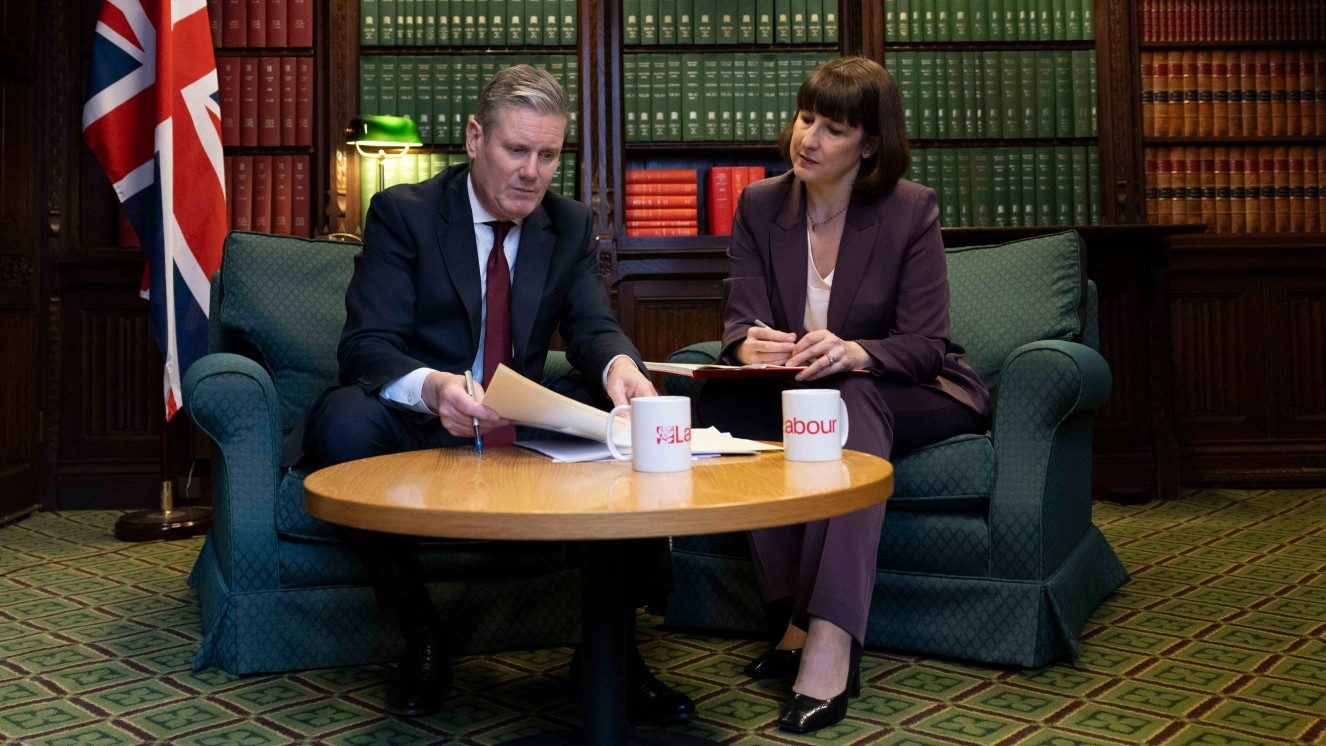Labour vs. Tories: which party will raise taxes the most?
What do the two main parties' manifestos say about their tax plans? And do their sums add up?

Whoever wins the general election, taxes will rise.
On the face of it, the Tories are touting a £17bn package of tax cuts, the biggest being a cut in the main rate of national insurance (NI) for employees. Labour promises to get by with limited tax increases, worth £8.6 billion, and has specifically ruled out hikes on "working people": income tax, national insurance and VAT.
But the consensus among economists is that neither major party is being honest with voters. Current government plans imply large real-terms cuts over the next few years in spending to departments that aren't protected by specific commitments (i.e. Health, Education and Defence). Barring an implausible uptick in growth, both parties face shortfalls if they are to avoid real-terms cuts to "unprotected" services such as courts, prisons, policing, legal aid and further education by the end of next parliament in 2028/29, says the independent Institute for Fiscal Studies (IFS). Tory plans imply a £10 billion to £20 billion shortfall forecast; Labour would need an extra £6 billion to £16 billion.
The Week
Escape your echo chamber. Get the facts behind the news, plus analysis from multiple perspectives.

Sign up for The Week's Free Newsletters
From our morning news briefing to a weekly Good News Newsletter, get the best of The Week delivered directly to your inbox.
From our morning news briefing to a weekly Good News Newsletter, get the best of The Week delivered directly to your inbox.
Why are public finances under pressure?
It is widely acknowledged that public services are crumbling after years of austerity, and that local councils face a funding crisis. Yet the UK's economic situation is still very tight. Extra borrowing to finance the fallout from the Covid pandemic and the Ukraine War energy shock, along with high interest rates and persistently low growth, have pushed up the ratio of debt to national income to an uncomfortable 97.9% of gross domestic product (GDP). Tax cuts are a tall order. But that's a difficult message for an electorate already labouring under a tax burden now at its highest level since the Second World War. Hence both parties' reliance on stealth taxes to fill the coffers, particularly the dark art of "fiscal drag".
What exactly is fiscal drag?
Freezing tax thresholds, rather than raising them with inflation, so that more people are drawn into paying higher taxes – even though tax rates ostensibly remain unchanged. In the aftermath of Liz Truss's disastrous mini-Budget in autumn 2022, Chancellor Jeremy Hunt froze both the tax-free "personal allowance" (currently at £12,570 for those earning under £100,000) and the higher-rate 40% tax threshold (£50,270) until 2028. Labour has confirmed that it will leave these thresholds untouched. The upshot, according to the Office for Budget Responsibility, is that some 7.5 million Britons will have moved bands by 2028, generating an increase in Treasury tax receipts of over £34 billion a year from 2028. It's a classic example of "the art of taxation", as Louis XIV's finance minister, Jean-Baptiste Colbert, described it: "plucking the goose so as to obtain the largest possible amount of feathers with the smallest possible amount of hissing".
What would Tory tax cuts do?
Most workers would be better off as a result of the manifesto plan to cut the main rate of NI by two further percentage points (from 8% to 6%) – worth around £450 for a worker on a typical salary of £35,400 (though they would lose £150 to fiscal drag). The Tories have also promised a "triple lock plus" on pensions, which will raise the tax-free allowance to keep it untaxed – a bung to older voters that could backfire if it draws attention to the fiscal drag dogging everyone else. The Conservatives also plan to boost the housing market by permanently abolishing stamp duty for first-time buyers on homes worth less than £425,000, though critics point out this would likely add to housing demand when the problem is lack of supply.
How would they pay for this?
They say that this £17 billion package of last-minute goodies will be paid for by a lightning-fast £12 billion reduction in the welfare bill, and a £6 billion clampdown on tax avoidance/evasion. Growing health-related benefits are likely to be the main target. But this would involve, say, getting roughly one million people (19% of the total) off health-related benefits, or applying big cuts to all claimants' payments, says the IFS. This seems implausible.
A free daily email with the biggest news stories of the day – and the best features from TheWeek.com
Do Labour's plans hold water?
Not as so far stated. Keir Starmer and shadow chancellor Rachel Reeves have said that they have "no plans" for tax rises beyond a handful of announced measures – including VAT on private school fees, ending the use of offshore trusts to avoid inheritance tax, clampdowns on "non-doms" and private equity bonuses, and a bigger windfall tax on energy companies. Critics think that is disingenuous. Although Rishi Sunak's claim that Labour would raise taxes by £2,000 "for everyone" has largely been debunked, this manifesto is notable for what isn't included. Though some hikes have been ruled out, others have been left on the table. Labour's tax-raising plans are "trivial" considering its ambitious proposals, says Paul Johnson of the IFS – for instance, to spend £17.5 billion over five years on its "green prosperity plan", and the likely pressure it will face to increase spending on public services.
Where would the necessary cash come from?
Changes to wealth taxes, such as inheritance tax (IHT) and capital gains tax (CGT), and a revamp of pension rules look like the most fruitful sources. An easy win would be to remove the exemption of pension funds from IHT introduced in 2015, or targeting the £15 billion in annual tax relief currently handed back to higher-rate taxpayers who save into pensions. Attention has particularly centred on CGT (currently charged at 10-28%, compared with the current 45% top rate of income tax) on the sale of assets including shares, property and businesses – though Starmer made a rare clarification: that the party would not charge capital gains tax on the sale of primary residences. Labour has been outflanked on the Left by the Lib Dems, who have pledged an additional £27 billion in spending for health and public services, funded by a rise in CGT and various levies.
Balancing the government books
In 2023/24, UK government spending was estimated to be £1.2 trillion, some £17,000 per person, and around 45% of the total size of the economy, as measured by GDP. (By contrast, in 2022, the US spent 36% of GDP, Germany 49%, and France 58%.) Around two-thirds of the total is "day-to-day" spending on public services, such as health (the biggest, at just over £200bn), schools and prisons. Around a quarter is spent on social security, such as universal credit and the state pension (which costs £124 billion, the largest item in the welfare budget). The remainder can be split into interest on government debt (around 8% of the total in 2023/24, above the recent norm because of high interest rates) and government investment (around 5%).
By contrast, the government's total income in 2023/24 was nearly £1.1 trillion. About two-thirds of receipts came from three sources: income tax (£277 billion), national insurance contributions (£180 billion) and VAT (£170 billion). Corporation tax contributed £103 billion, and council tax £45 billion. About £95 billion was generated from "other sources", largely income from public corporations such as social housing. The deficit, the difference between public spending and receipts, was £121 billion.
-
 All roads to Ukraine-Russia peace run through Donetsk
All roads to Ukraine-Russia peace run through DonetskIN THE SPOTLIGHT Volodymyr Zelenskyy is floating a major concession on one of the thorniest issues in the complex negotiations between Ukraine and Russia
-
 Why is Trump killing off clean energy?
Why is Trump killing off clean energy?Today's Big Question President halts offshore wind farm construction
-
 8 restaurants that are exactly what you need this winter
8 restaurants that are exactly what you need this winterThe Week Recommends Old standards and exciting newcomers alike
-
 4 tips to safeguard your accounts against data breaches
4 tips to safeguard your accounts against data breachesThe Explainer Even once you have been victimized, there are steps you can take to minimize the damage
-
 Received a windfall? Here is what to do next.
Received a windfall? Here is what to do next.The Explainer Avoid falling prey to ‘Sudden Wealth Syndrome’
-
 How to save more for retirement next year
How to save more for retirement next yearthe explainer Secure yourself a suitable nest egg
-
 Who will the new limits on student loans affect?
Who will the new limits on student loans affect?The Explainer The Trump administration is imposing new limits for federal student loans starting on July 1, 2026
-
 How to shop smarter with a grocery budget
How to shop smarter with a grocery budgetThe Explainer No more pushing your cart down the aisles on autopilot
-
 What will next year’s housing market look like?
What will next year’s housing market look like?The Explainer Here is what to expect from mortgage rates and home prices in 2026
-
 4 easy tips to avoid bank fees
4 easy tips to avoid bank feesThe Explainer A few dollars here and there might seem insignificant, but it all adds up
-
 4 often overlooked home maintenance tasks that could cost you later
4 often overlooked home maintenance tasks that could cost you laterThe Explainer A little upkeep now can save you money down the road